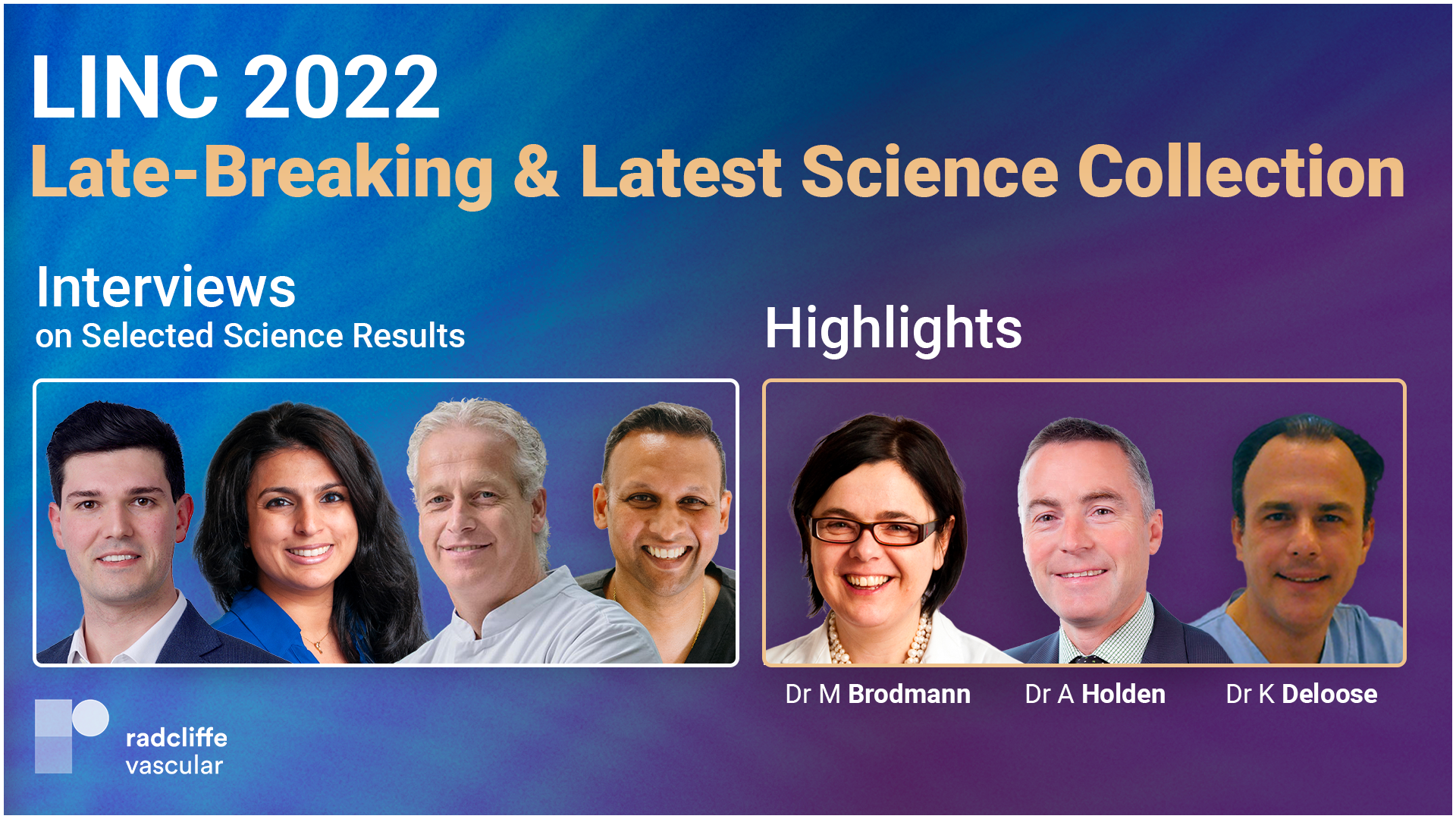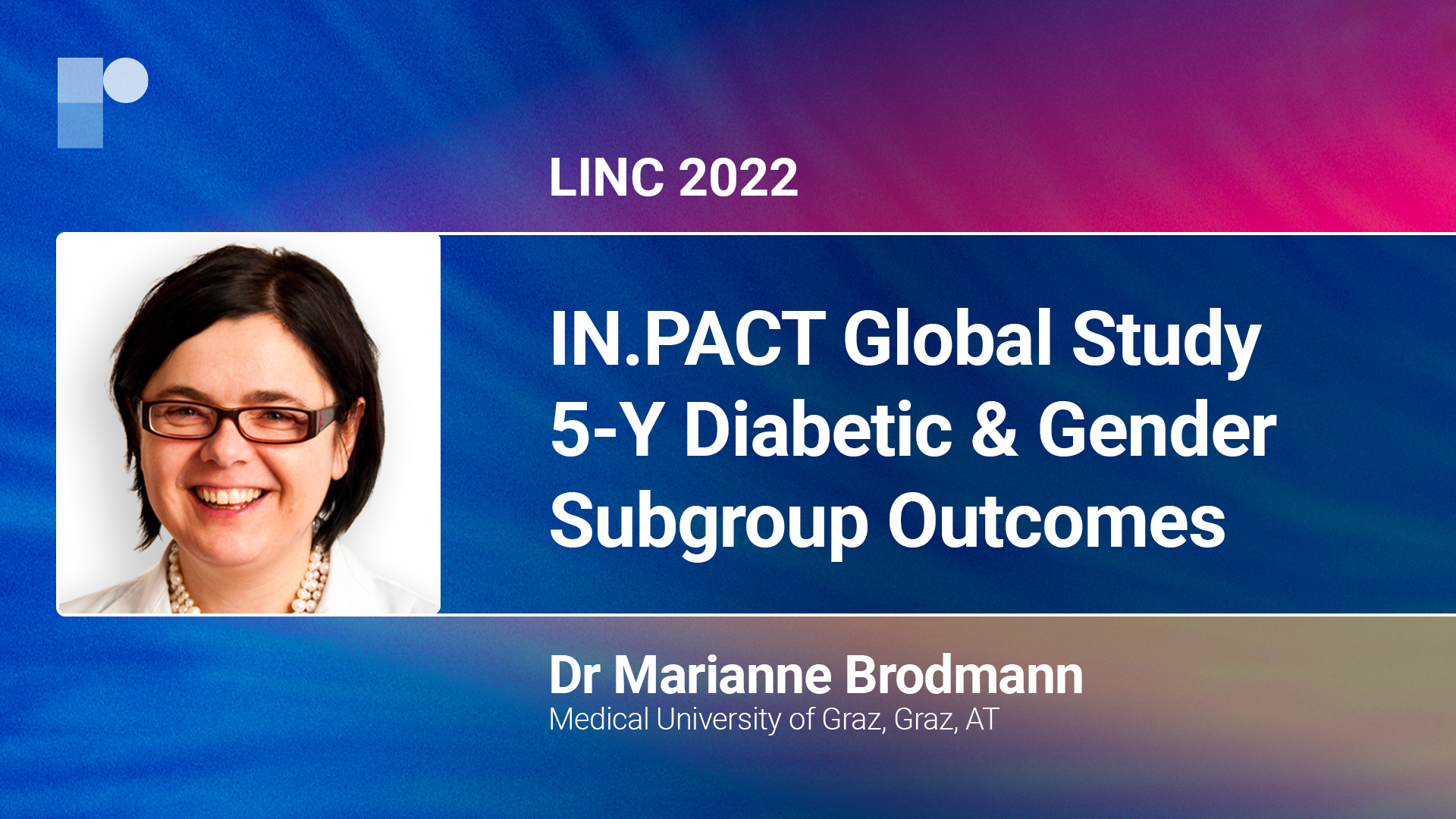- Good afternoon, everyone. My name is Stefano Barco. I'm a staff physician and head of research at the Department of Angiology of the University Hospital Zurich in Switzerland.
Advances in the Treatment of PAD
And today we will discuss the general study design and preliminary results of the SirPAD Randomised Controlled Trial. So PAD treatment is now broadening. And we have now multiple options, starting with medical therapy. And a number of devices are being currently approved for the use for patients with PAD.
Background of This Study
The unmet need beyond the SirPAD trial is the fact that we have now multiple therapeutic options for the treatment of infrainguinal PAD. But what we really need and what is highly expected is now also to have evidence that the new device, notably drug-eluting balloons, are also effective in terms of clinical outcomes. And this why we would like to test. And we are testing in the setting of this randomised control, all-comer, multicenter investigator-initiated trial that sirolimus-coated balloon are non-inferior and ultimately superior compared with plain old balloon in patients with infrainguinal PAD. And what we will test is whether the number of unplanned amputations or revascularization for critical limb ischemia is reduced in patients receiving sirolimus-coated balloon.
Device Studied
So we designed this trial as a Phase 3 randomised investigator-initiated trial. We have two main groups of treatment. The control group is composed of all CE-approved plain old balloons, so without coating of any medication. At the intervention group, the intervention treatment is represented by sirolimus-coated balloon. Why are they so novel and so special? Because of their Nanolute technology that actually allows the encapsulation of sub-micron-sized sirolimus drug into phospholipid on the surface of the balloon. And this surface is homogeneously encapsulated with drugs. And this allows a more uniform delivery of the drug until the deepest layer of the vessel wall but also would allow a most safer profile in terms of release of the drug only in the local lesion without dispersion in the circulation.
Study Design and Patient Population
So one of the main characteristics of prior trials is that there was a highly selected population being included in randomised control trials. And this of course limits the external validity of the main results. In the SirPAD trial, we wanted to include as many patients as possible, of course, but also trying to broaden the spectrum of PAD patients. This is why we limited the eligibility criteria to a very minimum. So we will have patients who require endovascularization because of infrainguinal PAD and who are not participating in any other interventional trial. Apart from these two key eligibility criteria, there are other standard eligibility criteria, notably pregnancy, allergy to sirolimus, or prior participation in the same trial. This will ensure that the patients are really representative of the all-comer population. And this is also why we managed to enrol more than 500 patients in almost 600 days, really showing that we are covering the whole spectrum of patients with infrainguinal peripheral artery disease.
Key Results
The trial, the SirPAD trial, has been started at the beginning of November 2020. Since then, we have included approximately 540 patients, which means approximately one patient per day. And we could now complete the first safety analysis of the trial to prove that mortality rate is similar in the two groups. So we have just analysed the data of the first 150 patients with at least one year of followup. And we could confirm that mortality rate in this patient population in the two groups was similar based on these results. The DSMB of the trial suggested continuation of the study until the next milestone. And we will perform multiple safety analysis for the hard clinical safety outcomes of all-cause death. The primary efficacy and outcome analysis is planned, however, after the 50% of enrollment of the patient population plus one year followup. So we will have the first data on efficacy outcome no earlier than June, July 2023.
Conclusions
So until now, we can conclude that sirolimus, at least based on the very first patients, 150, is as safe as standard balloons. This is the first conclusion. The second conclusion is that based on the baseline characteristics of the first 500 patients, we manage to enrol a sick population with severe comorbidities, therefore reflecting real-life world. And as I said, enrollment we continue until the enrollment of 1,200 patients or 1,200 patients, which are needed to show non-inferiority and possibly superiority of the sirolimus-coated balloon. So for the primary efficacy outcome, be a little bit more patient for the safety outcomes. I can confirm we have until now no signals that sirolimus-coated balloons are characterised by worse safety profile than normal plain old balloons.
Next Steps
So the next step would be now enrolling the target sample size population of 1,200 patients. This has to be expected over the next 18 months. And this will be a very much needed trial because it will finally include a large population of PAD patients and study hard clinical outcomes. So I think this will cover, this trial will cover, a substantial gap of knowledge for the treatment of PAD. And the results will be relevant also for future guidelines in the field.
LINC 2022: Late-breaking Science Video Collection
Published: 14 June 2022
-
Views:
 2666
2666
-
Likes:
 7
7
-
Views:
 2666
2666
-
Likes:
 7
7
-
 Up Next
Up Next -
 2m 39sPart 1 | Session 8 PRELUDE-BTK With Dr Lichtenberg: Serranator® PTA in Pts With PAD
2m 39sPart 1 | Session 8 PRELUDE-BTK With Dr Lichtenberg: Serranator® PTA in Pts With PAD -
 4m 46sPart 1 | Session 9 PRIZER Study: Renzan™ Stent in Pts With PAD
4m 46sPart 1 | Session 9 PRIZER Study: Renzan™ Stent in Pts With PAD -
 5m 16sPart 1 | Session 10 Auryon-SCE: Real-World Cohort Shows Promising Freedom from TLR at 6M
5m 16sPart 1 | Session 10 Auryon-SCE: Real-World Cohort Shows Promising Freedom from TLR at 6M -
 5m 32sPart 1 | Session 11 JET-RANGER: Jetstream Atherectomy & DCB In Pts With Complex Calcified Lesions
5m 32sPart 1 | Session 11 JET-RANGER: Jetstream Atherectomy & DCB In Pts With Complex Calcified Lesions -
 5m 43sPart 1 | Session 12 FLEX RCT: Micro-Incision prior to PTA in Pts With AVF
5m 43sPart 1 | Session 12 FLEX RCT: Micro-Incision prior to PTA in Pts With AVF -
 2m 46sPart 1 | Session 13 BioMimics 3D Stent: Safety and Efficacy in Real-World Patients
2m 46sPart 1 | Session 13 BioMimics 3D Stent: Safety and Efficacy in Real-World Patients -
 2m 44sPart 1 | Session 14 P-MAX Study with Dr Lichtenberg: ASPIREX®S Endovascular System
2m 44sPart 1 | Session 14 P-MAX Study with Dr Lichtenberg: ASPIREX®S Endovascular System -
 2m 15sPart 1 | Session 15 Cost-Effectiveness of Urea Excipient-Based DCBs for CLTI
2m 15sPart 1 | Session 15 Cost-Effectiveness of Urea Excipient-Based DCBs for CLTI -
 7m 57sPart 1 | Session 16 The CLariTI Study: Natural Progression of CLTI
7m 57sPart 1 | Session 16 The CLariTI Study: Natural Progression of CLTI -
 4m 19sPart 1 | Session 17 PAD in Germany 2009-2018 With Dr Rammos
4m 19sPart 1 | Session 17 PAD in Germany 2009-2018 With Dr Rammos -
 3m 26sPart 1 | Session 18 LINC 22: IN.PACT Global Study 5-Y Diabetic & Gender Subgroup Outcomes
3m 26sPart 1 | Session 18 LINC 22: IN.PACT Global Study 5-Y Diabetic & Gender Subgroup Outcomes -
 5m 20sPart 1 | Session 19 Patient Selection in NIVL and Preventing Migration in Venous Stenting
5m 20sPart 1 | Session 19 Patient Selection in NIVL and Preventing Migration in Venous Stenting
-
 4m 28sPart 1 | Session 1 GPX Embolic Device In Peripheral Applications Andrew Holden
4m 28sPart 1 | Session 1 GPX Embolic Device In Peripheral Applications Andrew Holden
-
 5m 32sPart 1 | Session 2 B-CLEAR Registry: Timing of TEVAR in Type B Aortic Dissection Erin Saricilar
5m 32sPart 1 | Session 2 B-CLEAR Registry: Timing of TEVAR in Type B Aortic Dissection Erin Saricilar
-
 4m 16sPart 1 | Session 3 Endovascular Angiography in Pts With Diabetic Foot Ulcers Using the Angiosome Model Erin Saricilar
4m 16sPart 1 | Session 3 Endovascular Angiography in Pts With Diabetic Foot Ulcers Using the Angiosome Model Erin Saricilar
-
 3m 58sPart 1 | Session 4 Cre8™ BTK Clinical Results in Complex BTK Patients Marc Sirvent
3m 58sPart 1 | Session 4 Cre8™ BTK Clinical Results in Complex BTK Patients Marc Sirvent
-
 4m 25sPart 1 | Session 5 AVF Formation with Adjuvant Endovascular Maturation Shannon Thomas
4m 25sPart 1 | Session 5 AVF Formation with Adjuvant Endovascular Maturation Shannon Thomas
-
 6m 16sPart 1 | Session 6 Long-Term Results of Supera in AVF Junta-Anastomosis Shannon Thomas
6m 16sPart 1 | Session 6 Long-Term Results of Supera in AVF Junta-Anastomosis Shannon Thomas
Overview
Short, accessible Expert Interviews will be available with select faculty focusing on the results, applicability, and impact on future research.
More from this programme
Part 1
Expert Interviews
Short, accessible Expert Interviews with select faculty focusing on the results, applicability, and impact on future research.
Faculty Biographies

Stefano Barco
Department of Angiology
Dr Stefano Barco completed his residency in internal medicine at the University of Pavia, Italy, and received a PhD in Vascular Medicine from the University of Amsterdam, the Netherlands. He leads a research group at the Center for Thrombosis and Hemostasis of the University Medical Center Mainz, Germany, and is staff physician at the Clinic of Angiology, University Hospital Zurich, Switzerland.
Transcript





